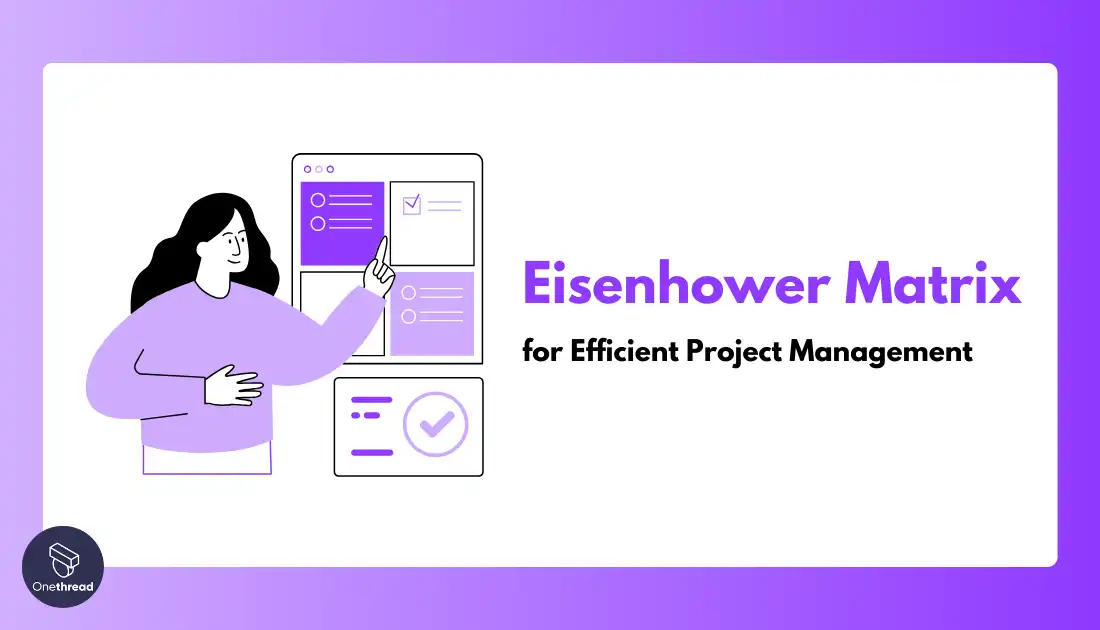Eisenhower’s Urgent/Important Principle is a time-management strategy that prioritizes tasks based on their urgency and importance. Tasks are categorized into four quadrants: urgent and important, not urgent but important, urgent but not important, and neither urgent nor important. It helps you focus on high-priority tasks and avoid procrastination. Anyone is juggling multiple projects and deadlines.
Want to learn how this simple yet powerful technique can revolutionize your productivity? Read on to discover the secrets of effective time management from one of America’s greatest leaders.
Key Takeaways:
- The Eisenhower Matrix sorts tasks by urgency/importance, enhancing focus and productivity.
- Prioritize crucial tasks; delegate when possible; eliminate low-value activities.
- Advanced strategies like task batching and the 80/20 rule optimize efficiency.
- Regularly review and adjust priorities to stay aligned with goals and adapt to changes.
What is the Eisenhower Matrix?
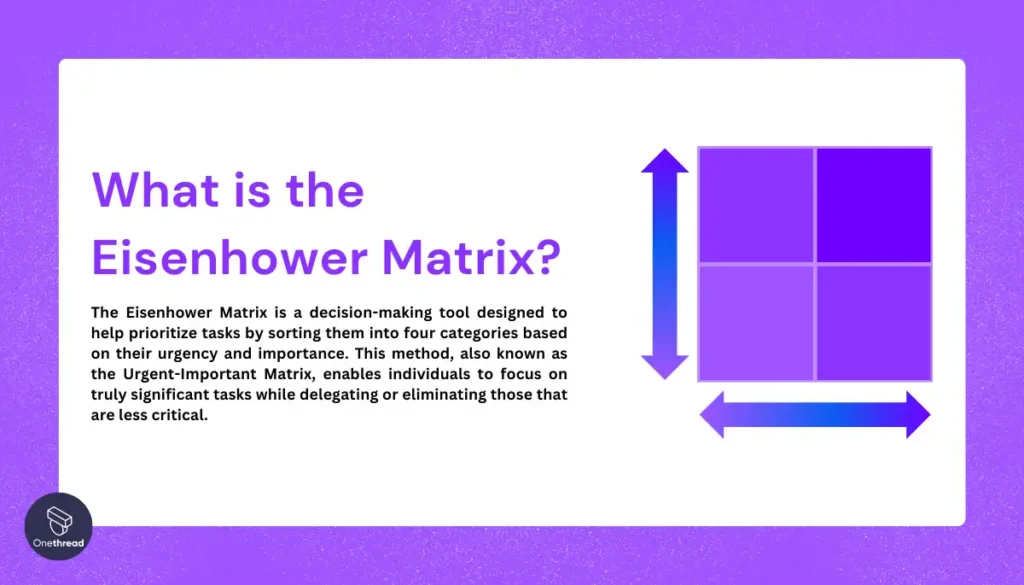
The Eisenhower Matrix is a decision-making tool designed to help prioritize tasks by sorting them into four categories based on their urgency and importance. This method, also known as the Urgent-Important Matrix, enables individuals to focus on truly significant tasks while delegating or eliminating those that are less critical.
The concept was popularized by Stephen Covey in “The 7 Habits of Highly Effective People” but is named after Dwight D. Eisenhower, the 34th President of the United States, who was renowned for his exceptional organizational skills and productivity.
Eisenhower famously differentiated tasks by their urgency and importance, focusing on those that were both urgent and important. He encapsulated this approach in a 1954 speech, quoting, “I have two kinds of problems, the urgent and the important. The urgent are not important, and the important are never urgent,” laying the groundwork for what would become the Eisenhower Matrix.
This matrix is a practical framework for organizing tasks, helping to combat procrastination, improving focus on long-term goals, and enhancing overall productivity.
Difference Between Urgent and Important Task
Urgent tasks require immediate attention as they have tight deadlines, while important tasks contribute to long-term goals but don’t necessarily need to be done right away. Understanding the difference between urgent and important tasks is crucial for effective time management and prioritization.
Urgent vs Important Tasks
Feature | Urgent Tasks | Important Tasks |
Time Sensitivity | High- Do now. | Low- Can wait. |
Example | Homework due tomorrow. | Reading for a report due later. |
Long-term Impact | Low- It's about the immediate. | High- It helps achieve goals. |
Understanding the difference helps you prioritize better, making sure you’re not just busy, but productive.
What are Urgent Tasks?
Urgent tasks are those that demand immediate action due to impending deadlines or time constraints. These tasks often come with consequences if not completed within a specific timeframe. Real-life examples of urgent tasks include:
- Responding to a client’s urgent request before the end of the day
- Fixing a broken water pipe in your home to prevent further damage
- Submitting a project report before the deadline set by your boss
Urgent tasks are usually time-sensitive and require your undivided attention until they are resolved or completed. Failing to address urgent tasks promptly can lead to negative consequences, such as missed opportunities, financial losses, or damaged relationships.
What are Important Tasks?
Important tasks are those that contribute to your long-term goals, values, or priorities, but they may not necessarily have a pressing deadline. These tasks are significant and meaningful, but they can often be scheduled or planned for later. Real-life examples of important tasks include:
- Developing a business plan for your startup idea
- Exercising regularly to maintain good health
- Saving money for your child’s education
Important tasks are usually more complex or require more time and effort, making them challenging to complete in one sitting. While they don’t have the same urgency as time-sensitive tasks, neglecting important tasks can hinder your progress toward achieving your long-term goals and objectives.
Importance And Benefits of The Eisenhower Matrix
The Eisenhower Matrix is a super tool to help you figure out what tasks you should do right away and which ones can wait. It’s like having a smart friend who tells you to focus on big-picture stuff and not just the noisy tasks that keep popping up. This way, you can be more productive, less stressed, and move closer to your big goals without getting lost in small stuff.
Importance of the Eisenhower Matrix
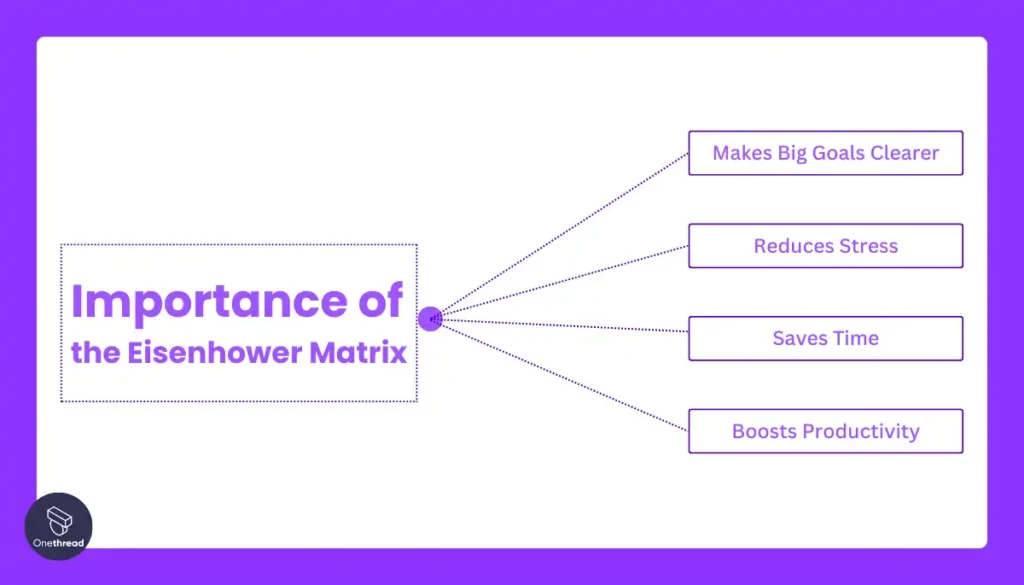
- Makes Big Goals Clearer: Helps you see how everyday tasks fit into your bigger dreams.
- Reduces Stress: Organizing tasks can help reduce feelings of overwhelm.
- Saves Time: Shows what’s really urgent, so you don’t waste time on less important stuff.
- Boosts Productivity: Focuses your energy on tasks that really matter, making you more productive.
Benefits of the Eisenhower Matrix
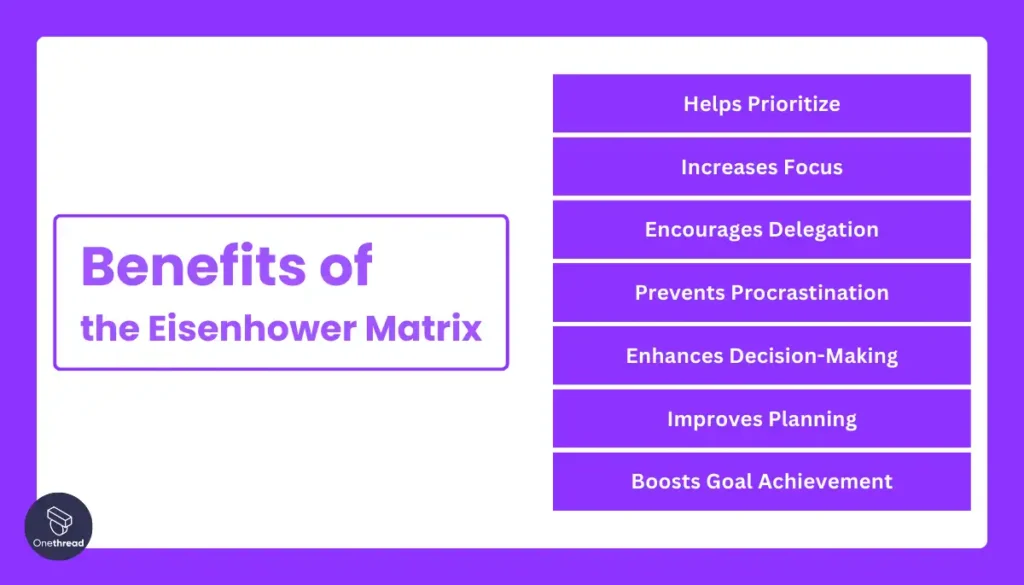
- Helps Prioritize: Teaches you to sort tasks by what’s urgent and important, so you know what to do first.
- Increases Focus: By knowing your priorities, you can give more attention to tasks that help you reach your goals.
- Encourages Delegation: Points out tasks you can hand off, so you’re not swamped.
- Prevents Procrastination: By scheduling important tasks before they become urgent, you avoid last-minute rushes.
- Enhances Decision-Making: Makes it easier to decide what to work on by clarifying what’s important.
- Improves Planning: Helps you plan your days and weeks better, fitting in both short-term and long-term tasks.
- Boosts Goal Achievement: By focusing on important tasks, you move closer to achieving your goals.
Using the Eisenhower Matrix is like having a map for your work and life goals. It guides you on what to do now, what to schedule for later, what to give to others, and what to skip altogether. This way, you can sail smoothly towards your goals without getting stuck in tasks that don’t really help you get there.
Disadvantages of The Eisenhower Matrix
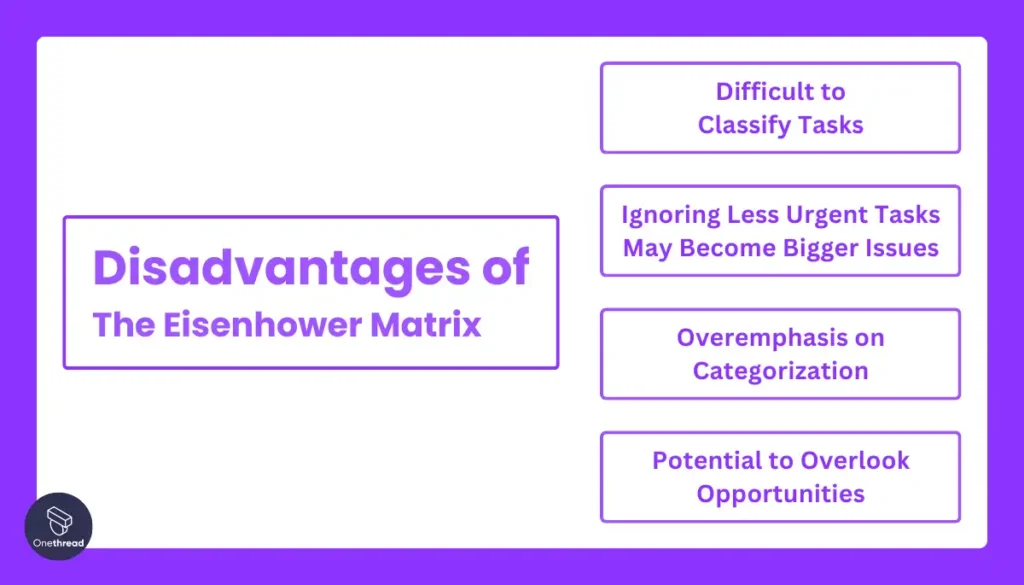
While the Eisenhower Matrix is great for sorting tasks and focusing on what matters, it’s not perfect. Sometimes, it can be tricky to figure out what’s truly urgent or important, leading to confusion. Also, this method might make us ignore small tasks that can quickly pile up and become a big headache later.
- Difficult to Classify Tasks
Sometimes, it’s hard to tell if a task is urgent, important, or both. This can make planning tricky.
Example: Deciding whether to answer emails or work on a project report due next week can be confusing.
- Ignoring Less Urgent Tasks May Become Bigger Issues
Small tasks that don’t seem urgent or important can grow into bigger issues if ignored for too long.
Example: Skipping regular check-ins with a team might lead to misunderstandings and delays in project work.
- Overemphasis on Categorization
You might spend more time deciding where tasks go in the matrix instead of actually doing them.
Example: Taking too long to sort tasks for the day and having less time to complete them.
- Potential to Overlook Opportunities
Strictly following the matrix might make you miss out on unexpected chances that could benefit you.
Example: Not attending an unplanned meeting that could have led to a new project because it didn’t fit into your urgent-important slot.
Knowing these disadvantages helps you use the Eisenhower Matrix wisely, balancing the need to prioritize with the flexibility to adapt to changing situations and opportunities.
The Four Quadrants of the Eisenhower Matrix Explained
The Eisenhower Matrix is an effective tool for prioritizing tasks based on their urgency and importance, dividing them into four distinct quadrants: important and urgent, important but not urgent, not important but urgent, and not important and not urgent. Here’s a breakdown of each quadrant to help you better manage your tasks:
Quadrant 1: Important and Urgent: Do Now
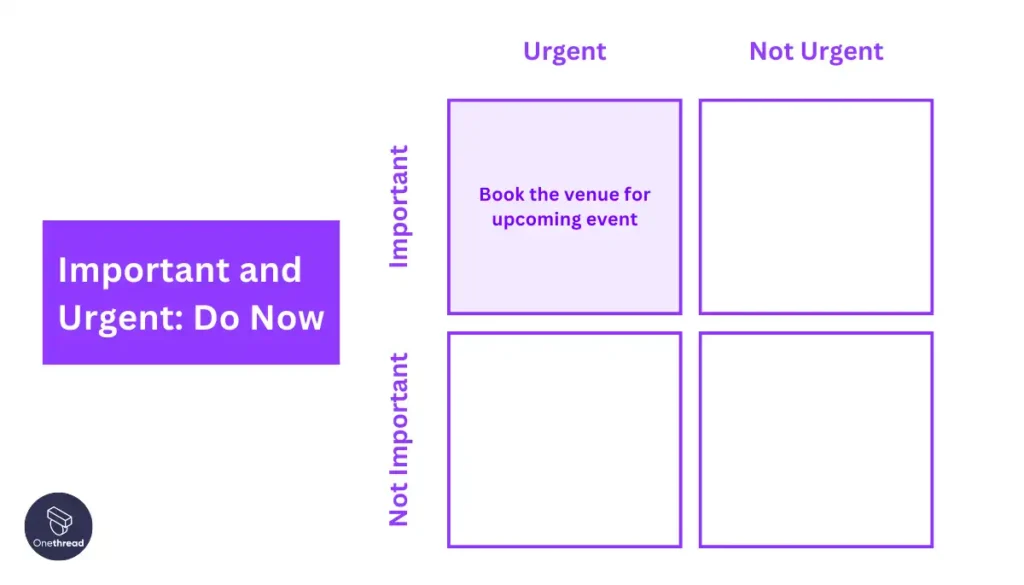
The “Important and Urgent” quadrant of the Eisenhower Matrix encompasses tasks that require immediate attention and are crucial for achieving your goals. This quadrant is reserved for deadlines, emergencies, and situations that cannot be postponed without significant consequences.
These are the tasks that sit at the top of your to-do list due to their immediate impact on your work or life. Prioritizing these tasks is essential to prevent crises and manage your responsibilities effectively.
However, constantly operating in this quadrant can lead to stress and burnout. The key is to manage your tasks proactively to minimize the number of items that fall into this high-pressure category, thereby achieving a more balanced and productive workflow.
Example: Securing the Event Venue
With the event date quickly approaching, finalizing the booking for the venue is crucial.
Without a confirmed location, the event cannot proceed as planned, making this task both important for the event’s success and urgent due to the looming deadline.
These tasks demand immediate action due to their urgency and significant impact on your goals or well-being.
Quadrant 2: Important but Not Urgent: Schedule for Later
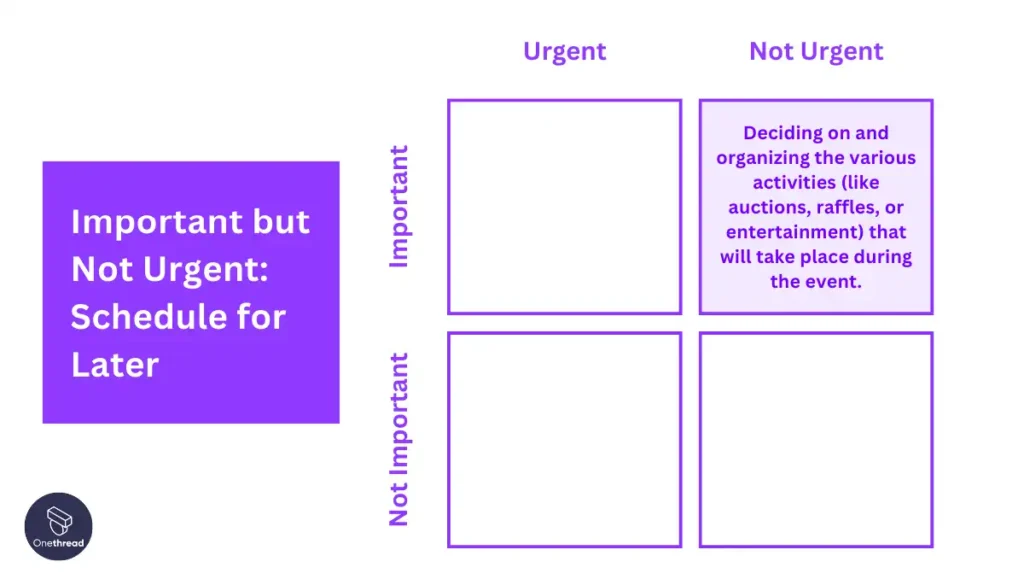
The “Important but Not Urgent” quadrant of the Eisenhower Matrix is where long-term planning and personal development tasks reside. These tasks are crucial for achieving your overarching goals and improving your life or career, but they do not require immediate action.
This quadrant includes activities like strategic planning, learning new skills, and building relationships. By scheduling these tasks, you ensure that they receive the attention they deserve without the pressure of an impending deadline.
Prioritizing this quadrant is key to personal growth and professional success, as it allows you to focus on the bigger picture and work towards your future objectives in a structured and stress-free manner. Effective time management in this quadrant leads to a fulfilling and productive life.
Example: Planning Event Activities
Deciding on and organizing the various activities (like auctions, raffles, or entertainment) that will take place during the event.
These tasks are key to ensuring the event is engaging and successful in raising funds but don’t need to be finalized immediately.
Scheduling time to carefully plan these elements is vital for long-term success.
These tasks are crucial for long-term success and personal fulfillment but don’t have an immediate deadline, allowing for scheduled completion.
Quadrant 3: Not Important but Urgent: Delegate to Others
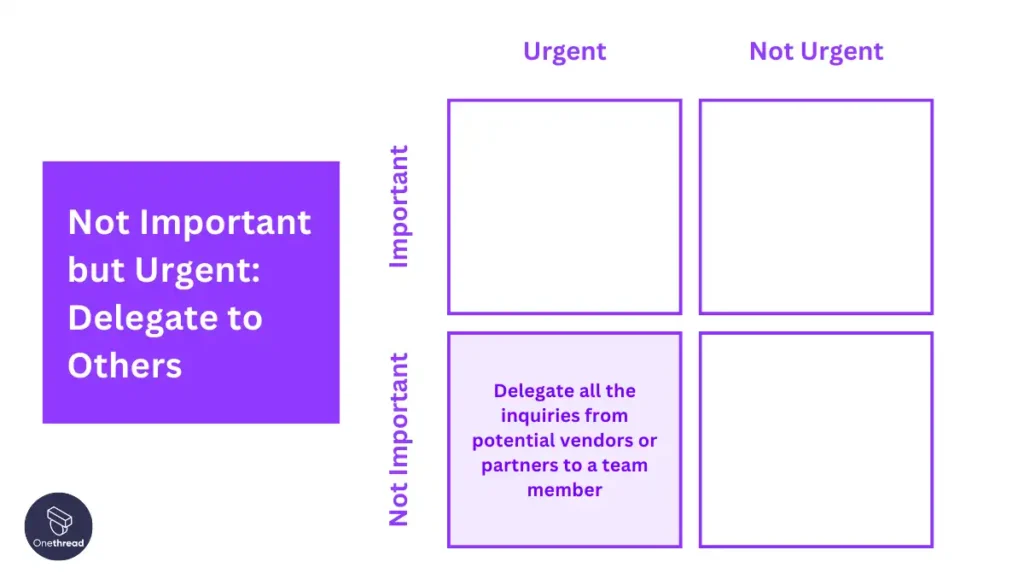
The “Not Important but Urgent” quadrant of the Eisenhower Matrix captures tasks that demand immediate attention but are less crucial to your long-term goals.
These activities often involve meeting the needs or requests of others, such as answering emails, attending unscheduled meetings, or handling minor crises that do not significantly impact your personal or professional growth. The strategy for managing these tasks is delegation.
By assigning these tasks to others when possible, you can free up your valuable time to concentrate on activities that are more important and contribute directly to your objectives. Delegating effectively requires recognizing which tasks require your expertise and which can be handled competently by others, thereby optimizing productivity and focusing on your priorities.
Example: Responding to Vendor Inquiries
As the event planning progresses, you’ll receive various inquiries from potential vendors or partners.
While responding is time-sensitive to keep everything on track, the task itself does not require your direct involvement and can be delegated to a team member.
This ensures timely communication without diverting your focus from more critical tasks.
These tasks need to be addressed quickly but don’t significantly contribute to your major goals, making them ideal for delegation.
Quadrant 4: Not Important and Not Urgent: Delete from The Task
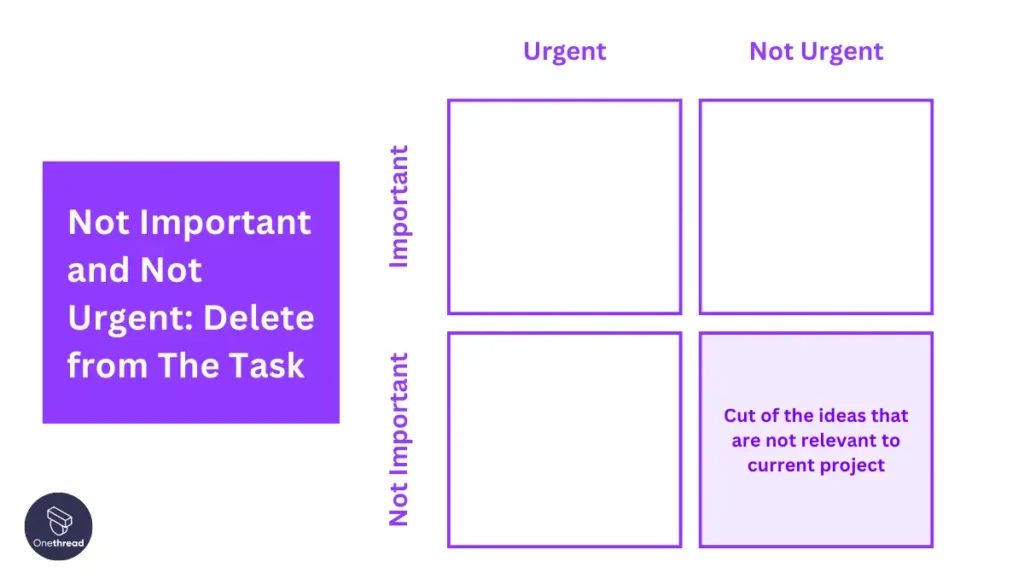
The “Not Important and Not Urgent” quadrant of the Eisenhower Matrix encompasses tasks that neither contribute to your goals nor demand immediate attention. These are the distractions and low-value activities that can easily consume your time if not managed properly.
Typical examples include mindlessly browsing social media, excessive television watching, or engaging in unproductive meetings. The recommended approach for these tasks is elimination. By removing these time-wasters from your schedule, you create more space for activities that are truly important and contribute to your personal and professional growth.
Focusing on this quadrant helps cultivate discipline and improve overall productivity, ensuring that your time is spent on tasks that align with your long-term objectives and priorities.
Example: Researching Unrelated Event Ideas
You might find yourself browsing through ideas for different types of events, like a community sports day or a cultural festival, that aren’t relevant to your current charity event.
While it might be tempting to explore these for inspiration, they don’t contribute directly to your current project’s success and can be cut from your immediate task list to free up time for more pressing matters.
These activities offer little to no value and can be eliminated to free up time for more important tasks, enhancing overall productivity and focus on achieving your objectives.
How To Use Eisenhower Matrix For Project Management?
Effective task prioritization is crucial for successful project management. The Eisenhower Matrix, a powerful time management tool, can help you prioritize tasks by categorizing them based on their urgency and importance.
By implementing this matrix in your project management workflow, you can ensure that critical activities receive prompt attention while less vital tasks are managed appropriately.
Step 1: Identify and List Tasks
Begin by compiling a comprehensive list of all tasks related to your project within Onethread, the best project management software for maximum efficiency.
For example, if you’re a software development startup, your task list might include activities like coding new features, fixing bugs, conducting user testing, and updating documentation.
Onethread’s intuitive “Tasks” feature allows you to create and manage tasks effortlessly, ensuring a complete overview of what needs to be accomplished.
You can capture details such as task descriptions, due dates, assignees, and priorities, laying the foundation for effective prioritization using the Eisenhower Matrix.
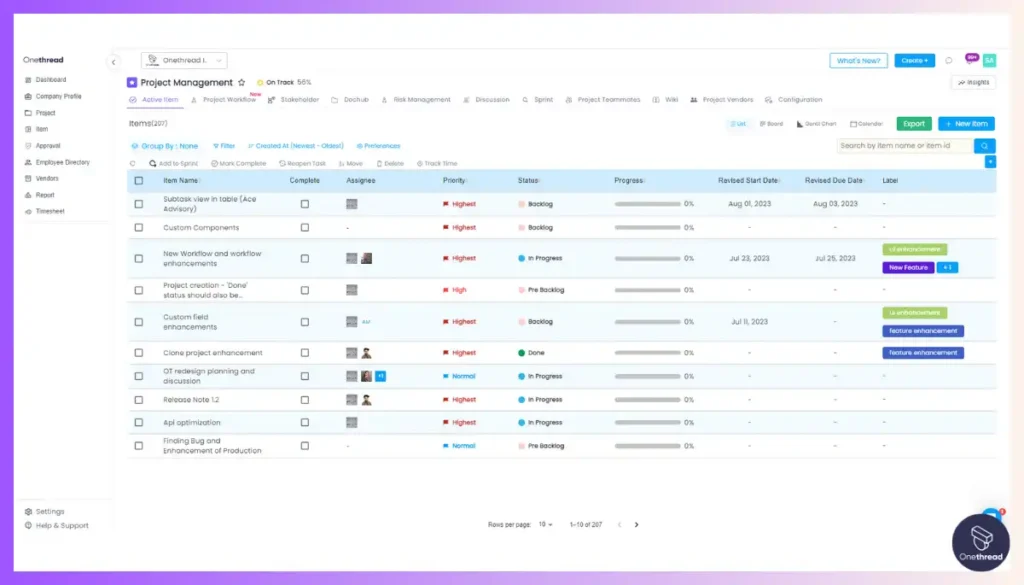
Step 2: Assess Urgency and Importance
Once you have a consolidated list of tasks, evaluate each task based on its urgency and importance. Consider the implications of delaying a task and its relevance to your project’s overall objectives.
For instance, fixing a critical bug that’s causing the app to crash would be considered both urgent and important, while updating minor documentation could be classified as less important.
Onethread’s user-friendly interface allows you to assign priorities to tasks, making it easier to identify urgent and important tasks.
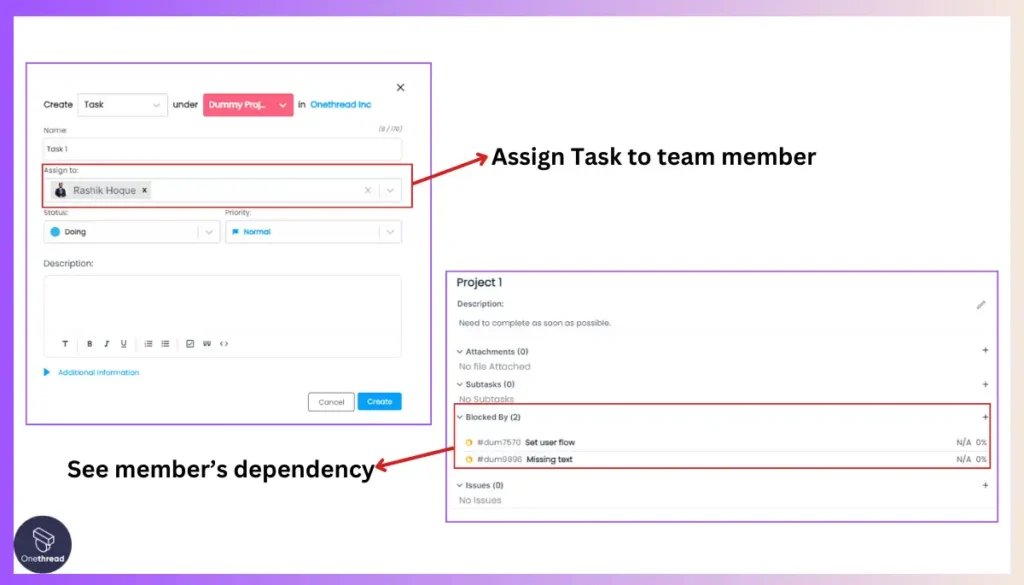
Additionally, you can leverage Onethread’s project dashboard to gain insights into task dependencies, milestones, and project progress, further aiding your assessment of task criticality.
Step 3: Categorize Tasks into Quadrants
Within Onethread, you can create custom workflows that correspond to the four quadrants of the Eisenhower Matrix:
- Important and Urgent: Tasks like resolving a major security vulnerability or meeting a strict client deadline would fall into this quadrant.
- Important but Not Urgent: Tasks such as conducting market research or revamping the company website could be crucial but not immediately pressing.
- Urgent but Not Important: Responding to non-critical emails or attending routine meetings could be urgent but not directly tied to core objectives.
- Not Important and Not Urgent: Activities like organizing team-building events or updating social media could be deprioritized or eliminated.
By assigning tasks to these custom workflows within Onethread, you can effectively categorize them according to the Eisenhower Matrix.
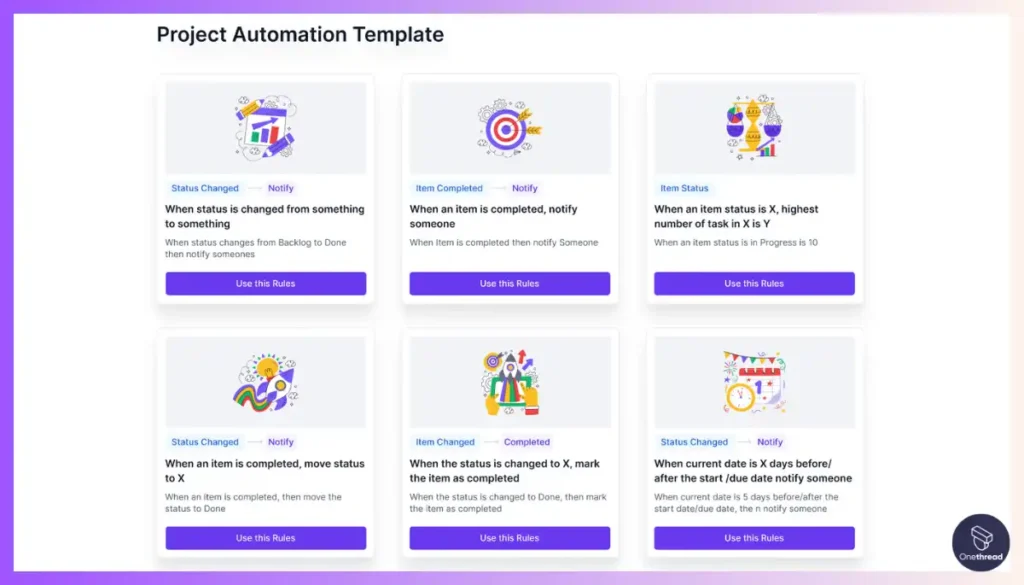
Onethread’s flexible workflows allow you to define specific stages, enabling you to track task progress within each quadrant seamlessly.
Step 4: Take Action
Focus your efforts on completing tasks in the “Important and Urgent” quadrant to mitigate immediate risks or capitalize on timely opportunities.
For example, if you’re launching a new product, tasks like finalizing the product features and securing necessary approvals would fall into this category.
Onethread’s task management features, such as due date reminders, priority indicators, and assignee notifications, can help you stay on top of these critical tasks.
The software’s built-in chat and collaboration tools also facilitate real-time communication, ensuring that your team can address urgent and important tasks efficiently.
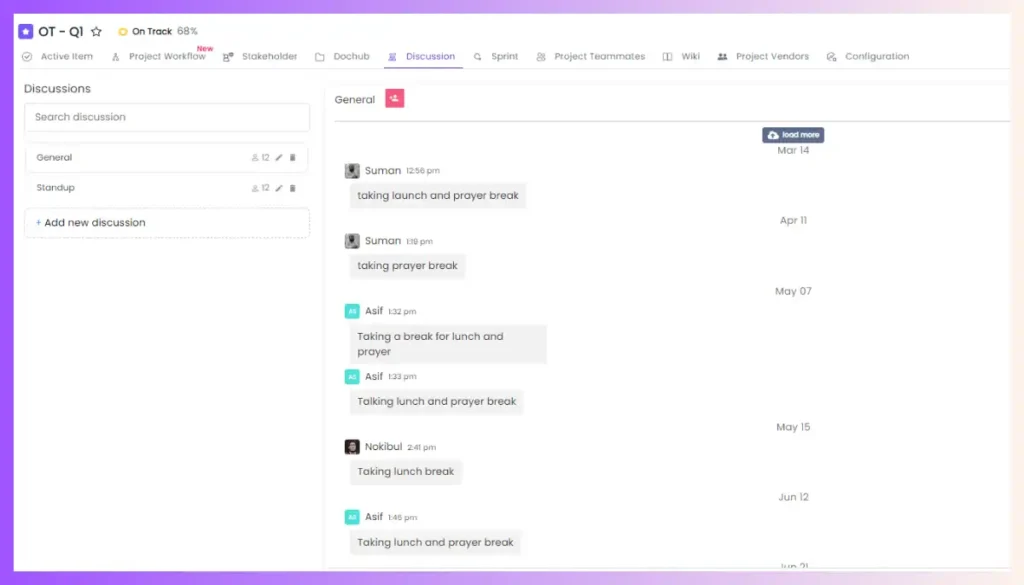
Additionally, schedule tasks from the “Important but Not Urgent” quadrant by allocating time in your project plan within Onethread.
For instance, you could plan for long-term initiatives like expanding to new markets or developing a new product line.
Onethread’s project scheduling capabilities, including Gantt charts and calendar views, can assist you in properly planning and executing these tasks before they become urgent.
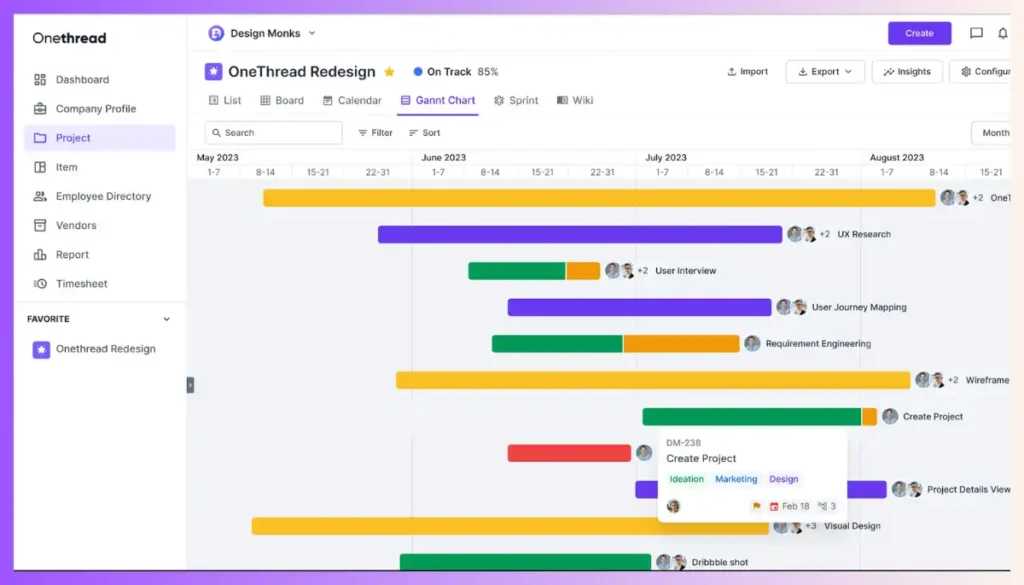
Step 5: Delegate or Eliminate
Identify tasks in the “Urgent but Not Important” quadrant that can be delegated to others, allowing you to focus on tasks only you can perform.
For example, if you’re the CEO of a startup, you might delegate tasks like responding to routine customer inquiries or scheduling team meetings to other team members.
Onethread’s project management features, such as task assignment and stakeholder management, enable you to delegate tasks effectively and maintain transparency throughout the process.
You can assign tasks to specific team members, set due dates, and track progress, ensuring that urgent but non-critical tasks are handled efficiently.
For tasks in the “Not Important and Not Urgent” quadrant, which offer little value to your project’s success, consider eliminating or minimizing the time spent on them.
Onethread’s project management tools can help you prioritize and allocate resources more efficiently, ensuring that efforts are directed toward tasks that contribute to your project’s objectives.
For instance, you might choose to deprioritize tasks like updating the company blog or participating in non-essential industry events.
Step 6: Review and Adjust Priorities
Regularly revisit your Eisenhower Matrix within Onethread, especially as project dynamics change. This ongoing review will help you adapt to new information, reprioritize tasks, and ensure that your project remains on track.
For instance, if a new competitor enters the market, you might need to reprioritize tasks related to market research and product differentiation.
Onethread’s real-time collaboration and communication features, such as discussion threads can facilitate effective communication with your team, enabling you to gather insights and adjust priorities accordingly.
You can share updates, solicit feedback, and make informed decisions about task prioritization based on the collective input from your team.
Step 7: Stay Flexible
Be prepared to adjust your strategy as necessary. New tasks may emerge, and priorities can shift based on project developments.
For example, if a major bug is discovered in your software, addressing it might become an urgent and important task, requiring you to reprioritize other activities.
Onethread’s agile project management approach allows you to adapt to changing conditions effectively.
The software’s flexibility in creating and modifying tasks, workflows, and project plans enables you to respond promptly to evolving requirements, ensuring that your Eisenhower Matrix remains relevant and actionable throughout the project lifecycle.
Step 8: Communicate Your Priorities
Ensure that your team understands the prioritization of tasks within the Eisenhower Matrix. Clear communication about the rationale behind task prioritization can help align team efforts and improve collaboration.
For instance, if you decide to prioritize developing a new feature over addressing minor bugs, communicating the reasoning behind this decision can help your team stay focused and motivated.
Onethread offers various communication channels, such as project discussions, stakeholder management, and shared project dashboards, facilitating seamless communication of priorities across your team.
You can engage in threaded discussions to gather feedback and leverage stakeholder management to ensure that all parties involved are aligned with the priorities.
Continuous Improvement
Implementing the Eisenhower Matrix is an iterative process. As you gain experience, you can refine your approach, optimizing the use of Onethread’s features to enhance task prioritization and project management efficiency.
Regularly review your team’s performance, gather feedback, and identify areas for improvement.
Onethread’s reporting and analytics capabilities can provide valuable insights into productivity, bottlenecks, and resource utilization, enabling data-driven decision-making and continuous process optimization.
For example, if you notice that tasks in the “Important but Not Urgent” quadrant are consistently being delayed, you can adjust your planning and resource allocation strategies accordingly.
By systematically applying the Eisenhower Matrix to project management with the help of Onethread, you can enhance your ability to prioritize tasks efficiently, leading to improved productivity, reduced stress, and more successful project outcomes for your startup or small company.
Try Onethread
Experience Onethread full potential, with all its features unlocked. Sign up now to start your 14-day free trial!
Advanced Tips and Strategies for Better Time Management
The Eisenhower Matrix is a powerful time management tool, but implementing advanced strategies can take it to the next level. Incorporate task batching, the 80/20 rule, and regular reviews to maximize efficiency and productivity while minimizing distractions and procrastination. Here’s how you can become even better at it:
- Task Batching: Group similar tasks together and work on them in a dedicated block of time. This approach minimizes context switching, allowing you to maintain focus and momentum. For example, schedule a block for administrative tasks, another for creative work, and so on.
- The 80/20 Rule (Pareto Principle): Identify the 20% of tasks that contribute to 80% of your results and prioritize them accordingly in the Eisenhower Matrix. This approach helps you focus on high-impact activities and avoid getting bogged down in trivial tasks.
- Use a Project Management Tool – It’s much better to follow the matrix with the help of a software tool Like Onethread that’ll reduce your clerical work. You can create, assign, and time tasks in a few clicks, while your whole team follows along.
- Regular Reviews: Periodically review and update your Eisenhower Matrix to ensure that your priorities align with your current goals and circumstances. This practice helps you stay agile and responsive to changing demands.
- Pomodoro Technique: Combine the Eisenhower Matrix with the Pomodoro Technique to enhance focus and productivity. Work on your important tasks in dedicated 25-minute intervals, followed by short breaks. This approach helps you maintain energy and concentration levels.
- Leverage Downtime: Use pockets of downtime, such as commutes or waiting rooms, to tackle quick but important tasks from your Eisenhower Matrix. This strategy helps you stay productive even during unexpected delays or lulls in your schedule.
- Reflection and Continuous Improvement: Regularly reflect on your time management practices and seek opportunities for improvement. Identify patterns or habits that hinder your productivity, and make adjustments to your Eisenhower Matrix approach accordingly.
By incorporating these advanced strategies, you can take your time management skills to new heights, ensuring that you consistently prioritize and accomplish the tasks that truly matter while minimizing distractions and maximizing productivity.
FAQs
What is the helpful purpose of an Eisenhower Matrix?
The Eisenhower Matrix helps prioritize tasks based on their urgency and importance, helping individuals manage their time effectively.
How do you use Eisenhower’s principle?
Categorize tasks into four quadrants: urgent and important, not urgent but important, urgent but not important, and neither urgent nor important. Prioritize accordingly.
How to use the Eisenhower Matrix for students?
Students can use the matrix to prioritize assignments, projects, and extracurricular activities, ensuring they focus on important tasks without neglecting urgent ones.
What are Eisenhower’s policies?
Eisenhower’s policies as the 34th US President included the Interstate Highway System, civil rights legislation, and the founding of NASA.
Final Words
The Eisenhower Matrix empowers you to conquer your project. It categorizes tasks based on urgency and importance, guiding you to prioritize effectively. By focusing on crucial tasks first, delegating what you can, and eliminating distractions, you’ll achieve more with less stress and reach your goals efficiently.
